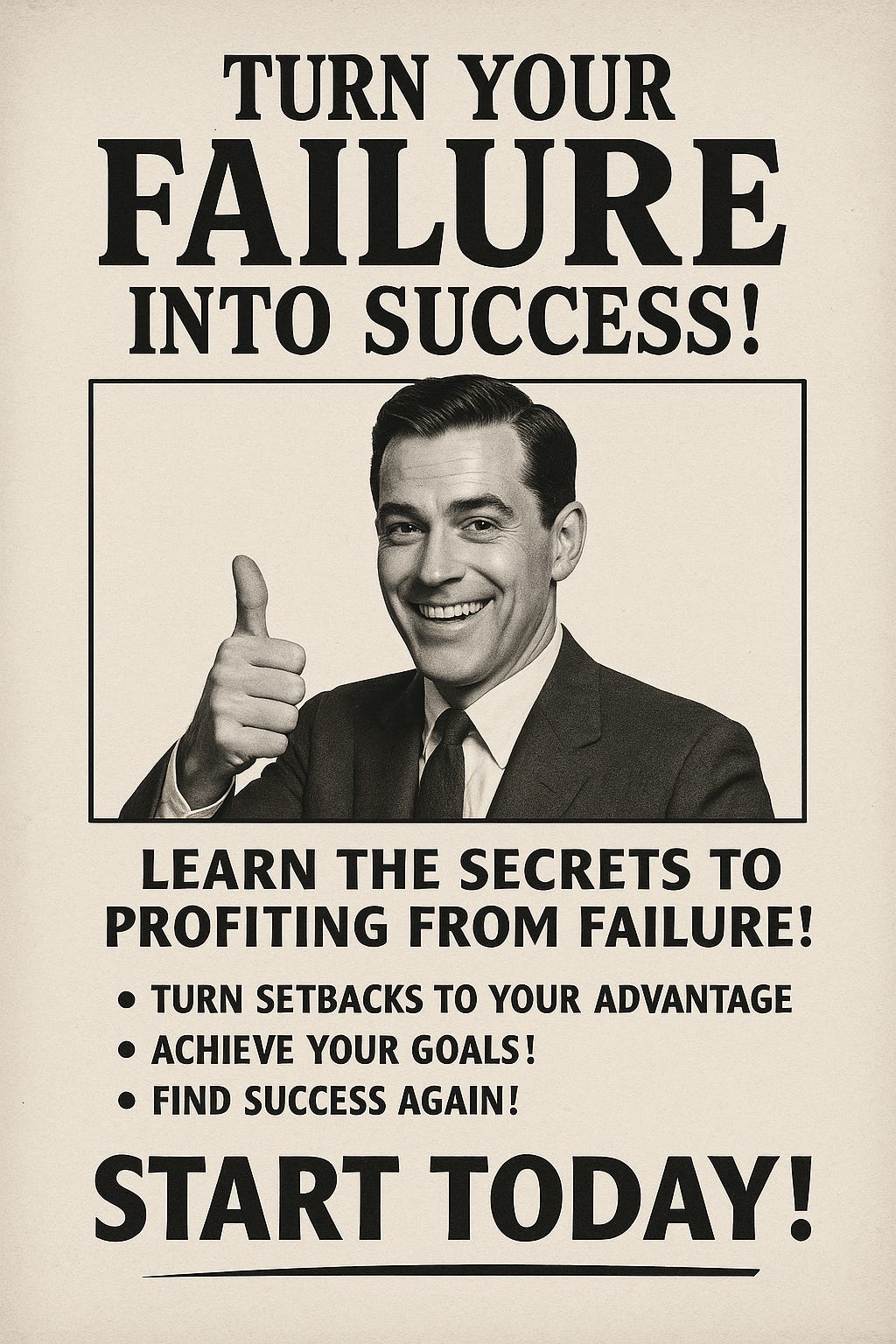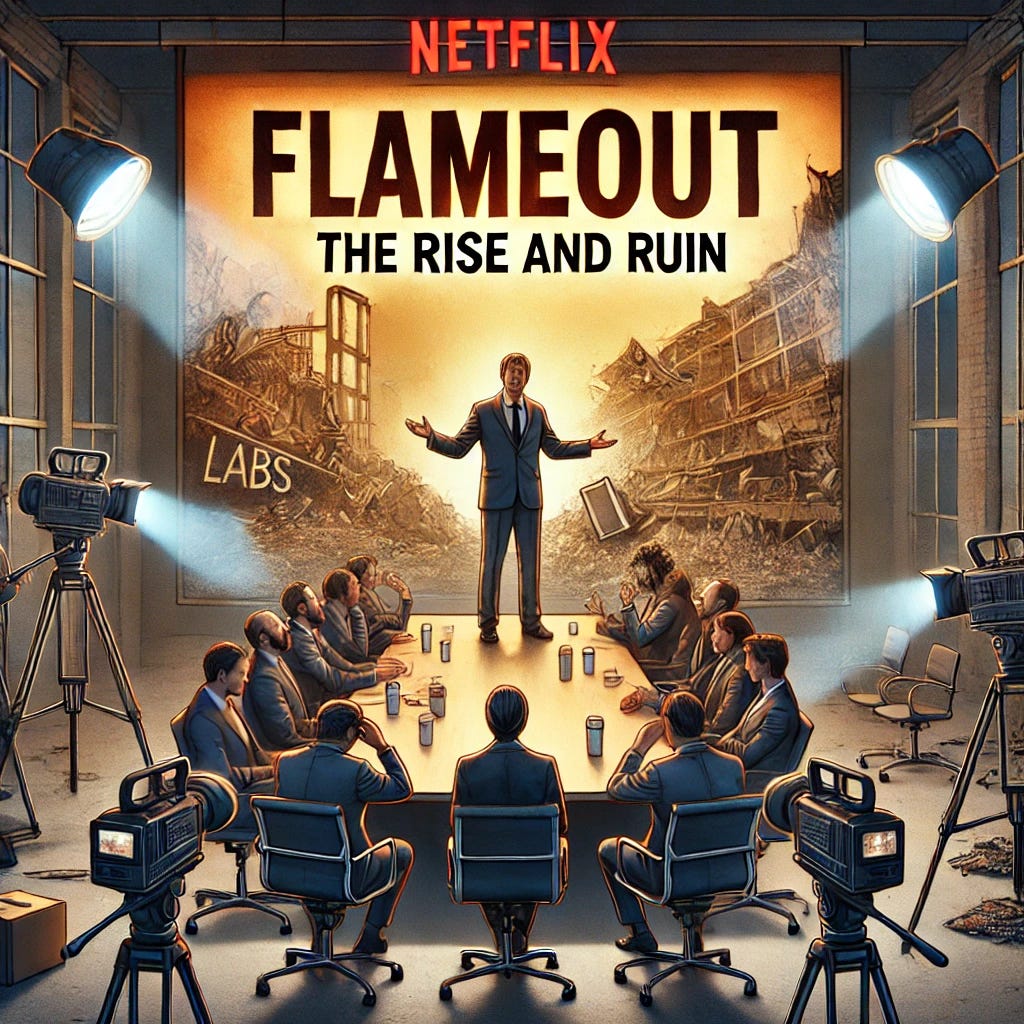RATLINKS: APRIL FAILURES
When Losing Big Means Winning Bigger: How screwing up became America's most reliable business model
RATLINKS: FAILURE, INC.
When Losing Big Means Winning Bigger: How Screwing Up Became America's Most Reliable Business Model
When the greatest investor of the 20th century warned us that "it takes 20 years to build a reputation and five minutes to ruin it," Warren Buffett missed the plot twist: those five-minute ruins would become more valuable than the preceding decades of building.
Welcome to the bizarre economics of Failure, Inc., where properly packaged catastrophe outperforms success in the marketplace of ideas, attention, and cold hard cash.
THE PRISON-TO-PODIUM PIPELINE
The day Nick Leeson walked out of Singapore's Changi Prison in July 1999, he was arguably more successful than the day he walked in. Yes, he had just served four years for fraud after losing $1.3 billion and destroying Barings, Britain's oldest merchant bank. But by the time he blinked in the sunlight, he'd already secured a six-figure book deal, a Hollywood adaptation starring Ewan McGregor, and a speaking career more lucrative than his old salary.
Leeson had pulled off the most lucrative career transition in finance: from failed trader to professional failure.
By 2008, Leeson was commanding speaking fees of up to $100,000. Financial institutions lined up to hear him explain exactly how he had destroyed one. The irony cuts deeper than a hedge fund manager's severance package. On his website, Leeson pitches his "practical examples" and "genuine business messages."
After all, who better to explain risk management than the man who demonstrated what happens when there isn't any? It's like hiring the iceberg to give safety tips to the Titanic.
THE IPO: INITIAL PUBLIC OBLITERATION
Lesson wasn't an anomaly, he was a pioneer of what would become a growth industry. Today, the hottest tickets at major financial conferences aren't steady successes but spectacular flameouts.
What explains this perverse marketplace where catastrophic failure becomes a career accelerant? The mechanics behind this phenomenon are both simpler and more disturbing than they appear.
"The thing about losing a billion dollars," Bill Hwang might as well have said after his Archegos Capital imploded in 2021, "is that you must have been impressive enough for someone to give you a billion dollars to lose in the first place."
That initial vote of confidence never fully disappears from your resume, even when you've turned $20 billion into financial vapor faster than a teenager with their first paycheck at a casino.
The pattern repeats with almost algorithmic precision as if programmed by the same people who design slot machines and social media feeds.
Take Jho Low, the Malaysian financier behind the 1MDB sovereign wealth fund scandal that siphoned off an estimated $4.5 billion. While technically a fugitive, Low's expertise remains so valued that financial institutions still quietly consult individuals connected to him for insights on Asian markets. It's like studying lock-picking from the world's most notorious jewel thief, ethically dubious but undeniably informed by specialized experience.
These aren’t just quirks of finance. They reflect a deeper truth, we trust people who've survived extremes more than those with spotless records.
The untested remain unproven; the failed are stress-tested and still standing. It’s like preferring a ship that’s weathered a hurricane to one that’s only sailed in calm seas.
This perverse dynamic isn't limited to high-profile financial scandals, it has filtered down to everyday professional life.
THE FAILURE INDUSTRIAL COMPLEX: MONETIZING MEDIOCRITY
This pattern of failure to fortune doesn't just play out in the rarefied air of high finance. It has become a democratic opportunity, accessible to anyone with a compelling downfall story and a LinkedIn account.
The formula for LinkedIn success has been refined to a science: take one part public humiliation, add two parts what I learned and finish with a garnish of vague inspiration. The recipe produces reliable results.
In 2019, LinkedIn published internal data showing that posts featuring professional setbacks and vulnerabilities received 160% more engagement than achievement announcements. A subsequent 2023 analysis from content marketing firm Semrush found that “failure story” posts averaged 327% more comments and 211% more shares than posts announcing promotions or company milestones.
Every week brings a fresh crop of confessionals:
"I got fired today. Here's what it taught me about customer success metrics."
Or
"My startup just lost $2M in funding. But here's the surprising leadership lesson I learned."
Reading LinkedIn in 2025 is like watching a bizarre competitive reality show. Contestants vie to transform professional faceplants into inspirational clickbait.
America's Got Failure or So You Think You Can Bounce Back?
The winners aren't those who succeed, they're those who package their failures most attractively for consumption.
Each post harvests likes and comments that function as the digital economy's version of participation trophies, except these trophies can be converted to actual speaking fees and book advances.
It's the professional equivalent of falling down the stairs at a party and immediately declaring it a masterclass in gravitational negotiation. The audience doesn't just forgive the stumble, they pay to hear how that tumble contains the secret to disrupting the staircase industry.
THE PROFESSIONAL ANTI-PORTFOLIO: SUCCEEDING THROUGH STRATEGIC FAILURE
There is a strange economic freedom that comes with having nothing left to lose.
The entrepreneur who's already filed for bankruptcy can take risks that the one protecting a perfect credit score cannot.
The investor who's already been publicly wrong can make contrarian bets that conventional wisdom rejects.
John Paulson, whose mega-bet against subprime mortgages made him billions in 2007-2008, only to be followed by a spectacular string of failures. After his historic "greatest trade ever," Paulson plunged into gold investments that cost his funds billions as the metal's price collapsed.
By 2016, his flagship fund had lost 85% of its assets under management. Many investors would have quietly faded into obscurity after such a reversal of fortune. Paulson’s reputation as the man who nailed “the greatest trade ever” allowed him to retain investor confidence, continue operations, and eventually score wins elsewhere.
Smart organizations don't just tolerate failure; they systematically incorporate it into their operations. Netflix's internal culture explicitly encourages risk-taking and learning from failure. Their now-famous "keeper test" asks managers to consider whether they would fight to keep each team member if that person were considering leaving. This creates an environment where bold experimentation is valued over safe mediocrity.
Pixar's creative process deliberately embraces "the ugly baby" stage of all new projects, recognizing that every great film begins as a deeply flawed concept. Their success comes not from avoiding failure but from creating systems that catch failure early and learn from it rapidly.
The U.S. Navy's TOPGUN program operates on a similar principle. Pilots are deliberately placed in failure scenarios during training because, as instructors explain, "It's better to sweat in training than bleed in combat." The controlled failures of training create resilience that prevents catastrophic failures in actual combat.
Behavioral economist Dan Ariely observed that fear of failure often produces worse outcomes than failure itself. His experimental research demonstrated that organizations paralyzed by failure avoidance consistently underperformed those that normalized small failures as learning opportunities.
THE ART OF THE FAIL: PROFESSIONAL FAILURE ARTISTS
Given these incentives, it's worth considering an unsettling possibility: Could entrepreneurs soon intentionally engineer failure for profit?
Think of them as financial performance artists, the Marina Abramović of corporate destruction, where the medium is venture capital and the art is losing it spectacularly while maintaining plausible deniability.
Here is a thought experiment:
Imagine a founder who raises $50 million specifically to orchestrate a spectacular, legal flameout, complete with pre-negotiated book deals and a Netflix documentary series.
The plan? A business that loses investor money so creatively that outsiders develop FOMO about missing the legendary disaster. Success was never the objective; the product was always the failure itself, carefully crafted for maximum entertainment value and minimum legal liability.
We're already seeing early examples. Several crypto projects have essentially operated as performance art pieces about financial folly, complete with dramatic crashes that generated more attention than their actual products ever did. Their founders didn't slink away in shame, instead, they capitalized on their newfound notoriety with podcasts, newsletters, and consulting gigs.
Remember MoviePass, perhaps the most brilliant failed business model of the digital era. The company offered unlimited movie tickets for $9.95 per month when a single ticket cost more than that in most markets - a business plan that guaranteed financial hemorrhaging from day one.
The result? As expected, MoviePass burned through $150 million in under a year with a model that any Econ 101 student could identify as unsustainable. Yet this spectacular failure made the company more valuable as an acquisition target than it ever was as a functioning business. Helios and Matheson Analytics purchased the failing company for $27 million, briefly saw their stock soar 1,400% during the peak of MoviePass mania, and managed to extract value from what was essentially a controlled demolition of venture capital.
Most ironically, MoviePass's spectacular implosion ended up validating the core business model. AMC Theaters, which initially dismissed MoviePass as financially suicidal, now operates its own subscription program (AMC Stubs A-List) at a sustainable price point—effectively learning from MoviePass's failure without paying the tuition. The company's CEO and memelord Adam Aron even acknowledged in a 2022 earnings call that “MoviePass taught the industry there was significant consumer appetite for subscription models in cinema.”
In this bizarre endgame of the attention economy, failure isn't just an option—it's the product. The line between genuine disaster and calculated content strategy blurs until it disappears entirely.
After all, in an economy built on stories rather than substance, the best storytellers will always find ways to profit, even when the story they're telling is about their own magnificent ruin.
FAILING UPWARD: YOUR STRATEGIC CATASTROPHE PLAYBOOK
So the next time you're standing in the smoking ruins of your latest catastrophe, remember: you're not experiencing a setback.
You're developing inventory for your future content strategy.
Your company didn't fail; it pivoted to becoming a case study.
You're not unemployed; you're a pre-famous keynote speaker in your chrysalis phase.
In the immortal words Samuel Beckett never intended as a business plan:
Ever tried. Ever failed. No matter. Try again. Fail again. Fail better.
Or as today's entrepreneurs might add
THE IRONY OF SUCCESS IN FAILURE
There's a delicious irony in publishing a newsletter about the profitable economics of failure. If this article underperforms, it validates its own thesis about failure's hidden value. If it goes viral, it proves that talking about failure is more engaging than celebrating success.
Either way, I can't lose which might be the most successful failure of all.
In a world where attention trumps achievement, even an analysis of failure can become the most successful thing you've ever done.
Did you enjoy this analysis of profitable failure?
Are you seeking someone to speak about a strategic disaster, failure monetization, and why losing sometimes beats winning?
Have you dreamed of having insights like these delivered live at your next corporate event?
If you are looking for a speaker for your next corporate event look no further.
Visit ratlinks.com/speaking for more information









I highly recommend checking out this essay on the profitable economics of failure. Evan offers a unique and hysterically funny perspective on the benefits of failure in the modern economy, using engaging writing and memorable anecdotes to make their points. The essay challenges "conventional wisdom" on the nature of success and failure. Whether you're an entrepreneur, a professional, or simply someone with a pulse, this essay is a must-read.